
The tranquil ambiance of a crystal-clear swimming pool on a sunny day is a summer dream come true. But when mustard algae, those pesky yellow patches, invade the pool’s serene waters, it can turn your aquatic haven into a nuisance.
Mustard algae, often mistaken for sand or dirt, can be challenging to identify and eliminate, raising questions about the safety of swimming in such waters.
In this comprehensive guide, we will explore mustard algae’s unique characteristics, how to identify it, and the crucial steps to prevent, treat, and ensure the safety of your swimming pool. Dive into the world of mustard algae, and learn how to enjoy your pool worry-free.
Understanding Mustard Algae

Mustard algae, often referred to as yellow or gold algae, emerges as tiny mustard-colored spots on the walls and floor of swimming pools. Its hue can resemble dirt, pollen, or sand, ranging from yellowish to yellow-green or yellow-brown.
What distinguishes mustard algae is its persistence; if the spots are brushed away but quickly reappear, it’s likely mustard algae.
Identifying Mustard Algae in Your Pool
Recognizing mustard algae involves close inspection of the spots. While it may resemble common debris, its recurrent nature sets it apart. If those yellow patches refuse to stay gone, you’re likely dealing with mustard algae.
A Glimpse at Common Pool Algae Varieties
Pools are no stranger to algae, with green, black, and mustard varieties causing various headaches for pool owners.
Green algae thrives in pools with poor water circulation or low sanitizer levels, while black algae forms stubborn, dark spots. Mustard algae, a green algae variant with its distinctive hue, challenges standard pool maintenance practices.
The Tenacity of Mustard Algae
Mustard algae’s resilience stems from its ability to survive in chlorine levels where other algae types falter. Even pools with ample chlorine can become a breeding ground for this persistent algae.
Furthermore, mustard algae clings to pool toys, floats, and swimsuits, spreading from one pool to another. Defeating it requires a more aggressive approach, including regular brushing, elevated chlorine levels, and consistent maintenance.
The Risks of Swimming in an Algae-Infested Pool
Bacterial Risk
Swimming in a pool with mustard algae poses more than just aesthetic concerns; it can also harbor harmful bacteria, notably E. coli. Exposure to E. coli can lead to gastrointestinal discomfort, manifesting as diarrhea, stomach cramps, and fever.
These symptoms can range from mild to severe, especially in vulnerable populations like children and the elderly.
Effects on Swimmers
While initially inconspicuous, a swim in an algae-infested pool can lead to discomfort and health issues. Swimmers may experience itchy or irritated skin, potentially developing rashes. Prolonged exposure could even induce nausea or respiratory distress, particularly if the algae release toxins.
Spreading the Algae
Mustard algae’s tenacity extends beyond one pool. Microscopic algae fragments can adhere to skin, hair, and swimwear, hitchhiking to cleaner pools or natural water bodies.
This introduces the risk of initiating new algae blooms in previously unaffected areas. Showering thoroughly after leaving an algae-infested pool and cleaning all swim gear can help mitigate this risk.
Low Visibility
Aside from health implications, mustard algae can impede swimmer safety. Thick algae growth clouds the water, drastically reducing visibility. This murkiness increases the chances of accidental collisions and injuries.
Swimming in such conditions is best postponed until the pool is thoroughly cleaned and the algae treated.
Preventing and Eradicating Mustard Algae

Maintaining Optimal Water Chemistry
Key to preventing mustard algae is maintaining balanced water chemistry in your pool. Regularly monitor pH, total alkalinity, and chlorine levels. Ideal parameters are a pH between 7.4 and 7.6 and total alkalinity between 100 and 150 parts per million (ppm).
Proper chlorine levels ensure a hostile environment for algae. Use a pool volume calculator to determine chlorine requirements for your pool’s size, and routinely test and adjust your pool’s chemistry for safe and enjoyable swimming.
The Vital Role of Proper Filtration
Your pool’s filtration system plays a vital role in algae prevention. A well-maintained system removes dirt, debris, and algae, keeping water clear and healthy. Check for clogs, clean or replace filter cartridges, and backwash sand or DE filters as needed.
Running the pool pump for at least eight hours daily enhances water circulation, limiting mustard algae growth. Regularly disinfect all pool equipment to prevent reintroducing algae.
The Importance of Regular Pool Cleaning
Consistent pool maintenance is crucial for preventing mustard algae. Establish a routine that includes brushing pool walls, steps, ladders, and surfaces to remove algae spores before they take hold.
Vacuum the pool floor and skim the surface for debris. Periodic algaecide and shock treatments help prevent mustard algae growth, but use them judiciously to maintain water chemistry.
Using Pool Shock Treatment
Pool shocking is a potent solution for mustard algae. This process involves temporarily elevating chlorine levels to eliminate bacteria and algae. Calcium hypochlorite-based shock treatments, like “Yellow Out,” target and eradicate stubborn mustard algae.
Follow label instructions, allowing the shock treatment to circulate for about 24 hours before testing chlorine levels and ensuring algae eradication.
Caring for Pool Equipment and Toys
Remember that mustard algae extends beyond pool water. Clean all pool equipment, toys, and swimwear exposed to the algae meticulously. A diluted bleach solution or specialized pool cleaning agent can effectively remove algae.
Scrub every item thoroughly, paying attention to crevices where algae may hide. Regularly backwash the filter to expel algae spores and prevent future outbreaks.
Conclusion
The allure of a pristine swimming pool can be compromised by mustard algae, but armed with knowledge and diligent maintenance, you can enjoy your pool safely. Mustard algae may be resilient, but so are the methods to prevent, identify, and treat it.
Protect the health and clarity of your pool, ensuring that every swim is a refreshing and worry-free experience. With the proper care and attention outlined in this guide, mustard algae will be nothing more than a fleeting inconvenience in your pool paradise.









